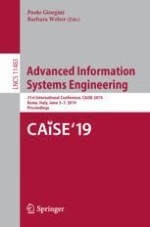This book constitutes the refereed proceedings of the 31st International Conference on Advanced Information Systems Engineering, CAiSE 2019, held in Rome, Italy, in June 2019.
The 41 full papers presented in this volume were carefully reviewed and selected from 206 submissions. The book also contains one invited talk in full paper length.
The papers were organized in topical sections named: information system engineering; requirements and modeling; data modeling and analysis; business process modeling and engineering; information system security; and learning and mining in information systems.
Abstracts on the CAiSE 2019 tutorials can be found in the back matter of the volume.
